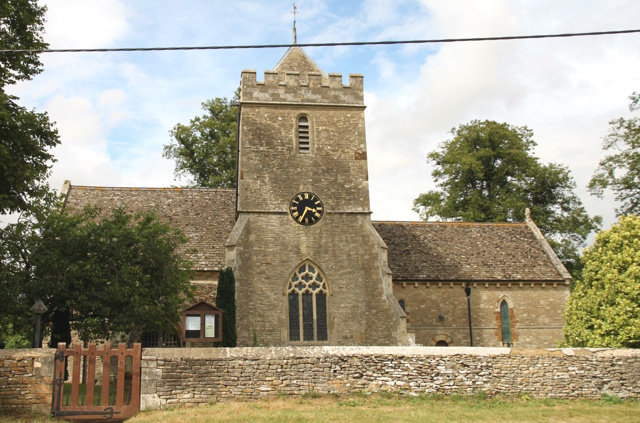


























St. Peter's Church, Stoke Lyne
St. Peter's Church at Stoke Lyne comprises a chancel, nave, and north and south transepts, with a tower over the south transept. The nave and chancel were built in the 12th century, and both the chancel arch and the fine south doorway are Romanesque work of this period. Over the doorway there is a niche containing a contemporary statue of a seated figure, probably St. Peter. There is a 19th-century porch. The south transept was added early in the 14th century and forms the lower stage of the tower. This is lighted by a three-light window with reticulated tracery, and has an embattled parapet and a pyramidal roof. Its repair or alteration in 1658 is recorded by an inscription on the exterior. The church once had a northern aisle. Christopher Pettie is said to have been buried in it in 1651, but it had been destroyed by the early 19th century with the exception of the eastern bay, which was reconstructed to form a quasi-transept. The blocked-up arches of the arcade can still be seen in the north wall of the nave. Repairs in 1757 included repointing the tower, plastering the roof, and walling up one of the doors. By the mid-19th century the church was in a dilapidated condition: the chancel walls and roof were in need of repair, the floors were uneven, and the walls green with damp. In 1868–9 the church was re stored at a cost of £2,130; the architect was H. Woodyer, the builder C. Chappel. The chancel was rebuilt on the old foundations: the three Romanesque windows at the east end were copied from the originals, but the circular window above them was a new feature. The stained glass was given by Lady (Algernon) Peyton in 1873. The walls of the nave were repaired and a new west window built. The tower was raised and buttressed and battlements were added. The porch was rebuilt, a vestry added, and the church reseated. In 1951 the chancel was again restored and refurnished by Sir Algernon and Lady Peyton. The Victorian reredos was removed, and a new altar and altar rails of unstained oak installed. The whole effect of the white-washed interior is one of extreme simplicity and beauty. The round font is medieval. Ten pews were installed in 1654, but the other existing ones are modern. In 1873 Lady Peyton also gave an organ, and electric light was installed in 1949, the brackets being made at the local forge. There is a fine brass to Edward Love (d. 1557) and his wife Alice (d. 1535/6); and an altar-tomb with brass to William Holt (d. 1582/3) and his wife Katherine Dormer. There is a monument to Ralph Holt (d. 1702) and his two wives; and inscriptions to Charnell Pettie (d. 1661/2) and to Susanna Holt (d. 1704), wife of the Revd. Edmund Major. There are two Peyton tablets. Those to Elinor Pettie (d. 1662/3), Christopher Pettie (d. 1651), Charles Holt (d. 1731), Eustace Pettie (d. 1735), George Fletcher, vicar (d. 1734), could not be traced in 1956. The coats of arms seen by Rawlinson in a window in about 1718 were also no longer there. Stoke Lyne is not included on the chantry commissioners' usual list, but there was a light at the Reformation which was supported by land worth 1s. 6d. a year and three animals, given by Thomas Grevell, gent. In 1955 the only valuable pieces of plate were a silver chalice and paten cover of 1637. There were three bells, none earlier than 1812. The registers date from 1665, but the volume for 1753–1813 is missing; Rawlinson mentioned an earlier one which was already lost. Historical information aboutSt. Peter's Church is provided by 'Parishes: Stoke Lyne', in A History of the County of Oxford: Volume 6, ed. Mary D Lobel (London, 1959), pp. 312-323. British History Online http://www.british-history.ac.uk/vch/oxon/vol6/pp312-323 [accessed 21 February 2023]. St. Peter's Church is a Grade II* listed building. For more information about the listing see CHURCH OF ST PETER, Stoke Lyne - 1193248 | Historic England. For more information about St. Peter's Church see Parishes: Stoke Lyne | British History Online (british-history.ac.uk). |

